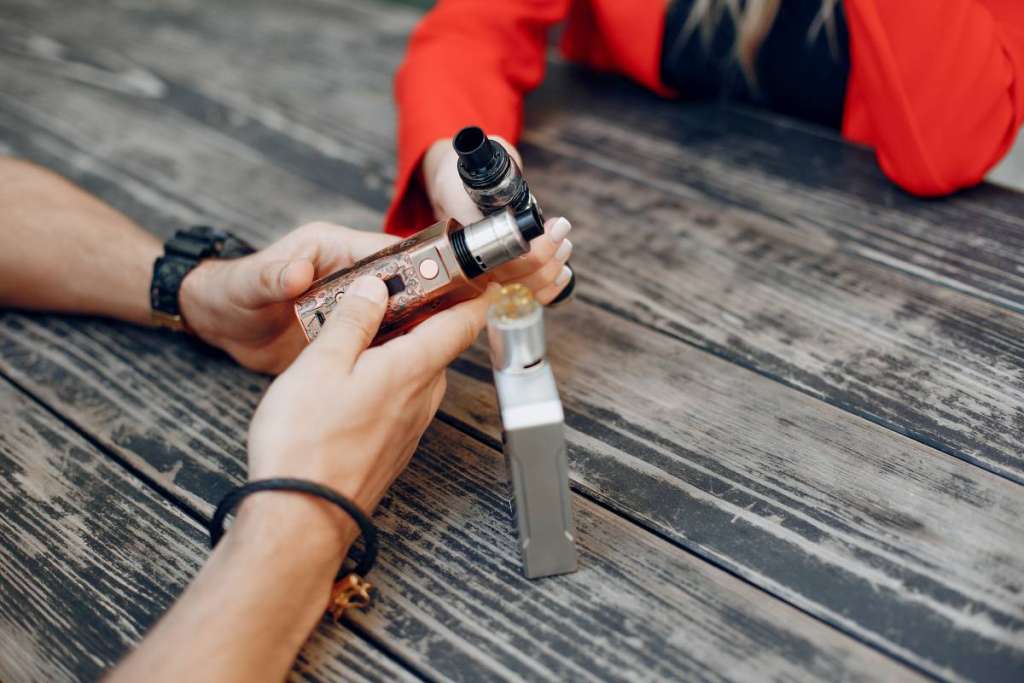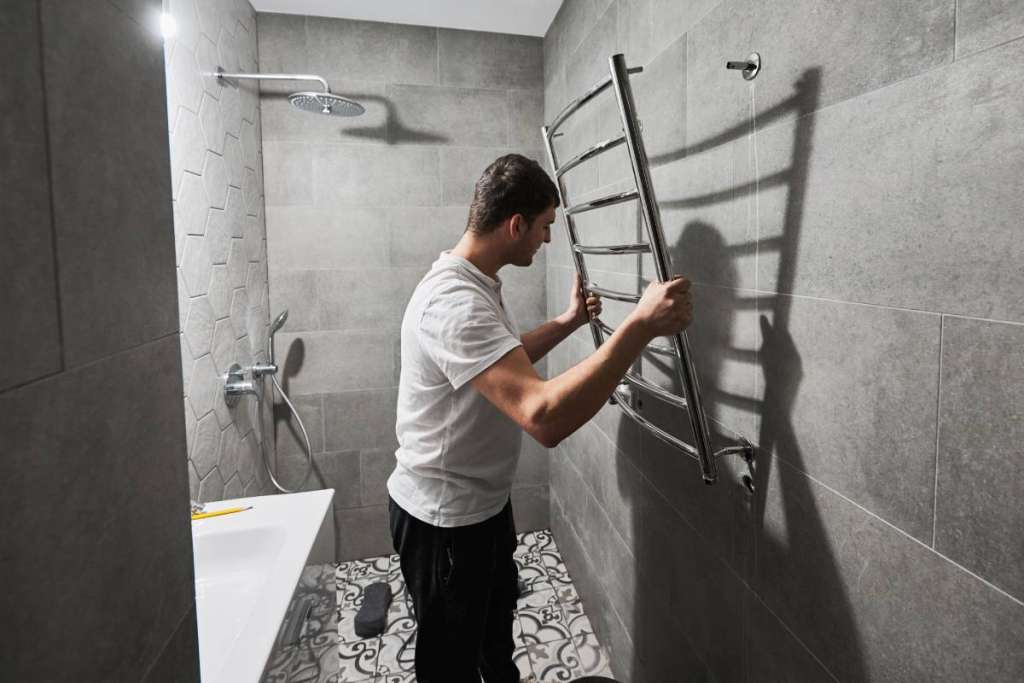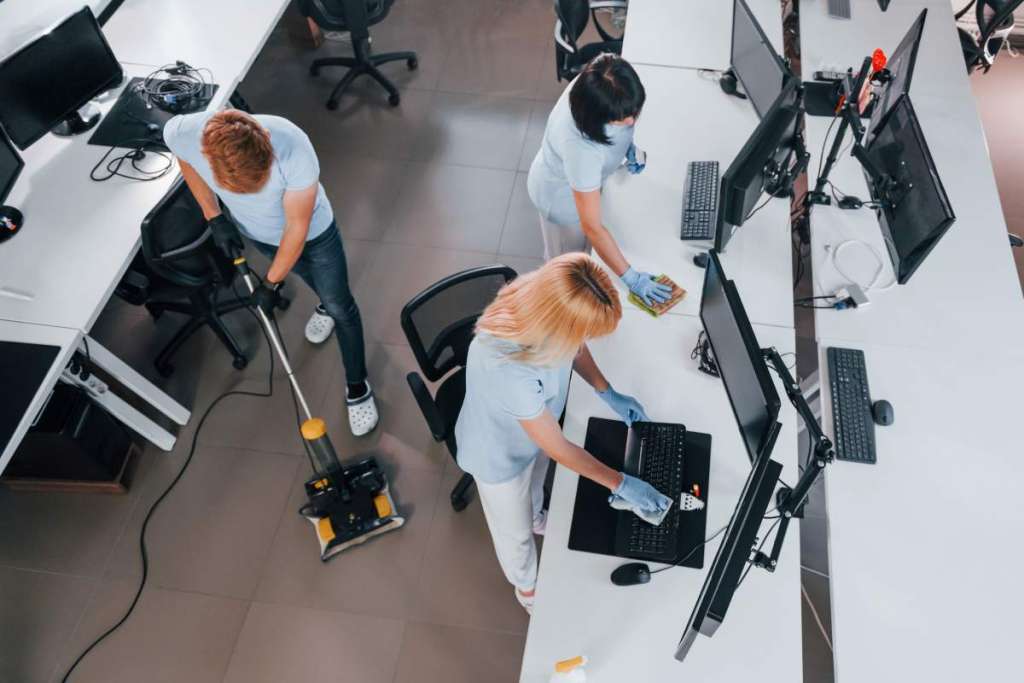Why Vaping Is So Popular Among Teenagers 9 Feb 9:48 PM (last month)
Vaping has really taken off among teenagers around the world in recent years. What started as a way for adults to quit smoking has quickly caught on with younger people, which has parents, teachers, and health experts worried about this kind of lifestyle.
There are a bunch of reasons why vaping is so appealing to teens—things like clever marketing, peer pressure, easy access, and some misconceptions about how safe it is.
This article dives into why so many teenagers are into vaping, the risks that come with it, and what can be done to tackle the issue.
The Appeal of Vaping to Teenagers
1. Flavor Variety and Attractive Packaging
One of the key reasons teenagers are drawn to vaping is the availability of a wide range of flavours. Unlike traditional cigarettes, which have a strong and often unpleasant taste, vape products come in flavours like fruit, candy, mint, and dessert.
This variety makes vaping more appealing and enjoyable for young users. Additionally, the packaging of vape products is often colourful and designed to look trendy, making them attractive to teenagers.
2. Social Influence and Peer Pressure
Teenagers are heavily influenced by their peers, and vaping has become a social activity among many groups. Seeing friends or classmates use vape devices makes it seem normal and even desirable.
Social media platforms, where influencers and celebrities showcase vaping, also contribute to its normalization among teenagers. Many teens start vaping to fit in with their peers, avoid feeling left out, or appear trendy.
3. Perceived as a Safer Alternative to Smoking
Many teenagers believe that vaping is a safer alternative to smoking cigarettes. Unlike traditional tobacco products, which are known to contain harmful chemicals and cause severe health issues, vaping is often marketed as a “cleaner” option with fewer risks.
This perception, however, is misleading since vaping can still have serious health consequences, particularly for young people whose lungs and brains are still developing.
4. Easy Accessibility and Discreet Use
Despite age restrictions, many teenagers find it easy to access vape products. Online shopping, lax enforcement of sales regulations, and older friends or siblings providing access contribute to the widespread availability of vaping devices. Additionally, many vape devices are small, sleek, and easy to hide, making them convenient for discreet use at school, home, or social gatherings.
5. Nicotine Addiction and Dependency
Many vape products contain high levels of nicotine, a highly addictive substance. Teenagers who start vaping may develop a dependency on nicotine, leading to regular use and increased cravings. Nicotine addiction can affect brain development, leading to problems with attention, learning, and impulse control. The highly addictive nature of vaping makes it difficult for teenagers to quit once they start.
6. Influence of Social Media and Celebrity Endorsements
Social media platforms like TikTok, Instagram, and YouTube play a significant role in promoting vaping among teenagers. Influencers and celebrities who showcase vaping in their videos make it appear fun, harmless, and socially acceptable. Many teens look up to these personalities and are likely to imitate their behaviours, contributing to the growing vaping trend.
The Risks and Consequences of Teen Vaping
While vaping is perceived as less harmful than smoking traditional cigarettes, it still poses serious health risks, especially for young people. Some of the key dangers include:
1. Health Risks and Lung Damage
Vaping can cause severe lung damage and respiratory issues. There have been numerous reports of lung injuries associated with vaping, known as EVALI (E-cigarette or Vaping Use-Associated Lung Injury). Some teens who vape have developed serious breathing problems, chronic coughs, and lung inflammation.
2. Nicotine Addiction and Brain Development Issues
Teenagers’ brains are still developing, and nicotine exposure can interfere with cognitive functions, memory, and concentration. Nicotine addiction at a young age can also increase the likelihood of addiction to other substances later in life.
3. Increased Risk of Transitioning to Cigarettes
Studies have shown that teenagers who start vaping are more likely to transition to smoking traditional cigarettes. The habit of inhaling nicotine through vaping can pave the way for the use of other tobacco products, leading to long-term health issues.
4. Mental Health Concerns
Vaping has been linked to increased anxiety, depression, and mood swings in teenagers. Nicotine can affect the brain’s reward system, leading to changes in mood and behaviour. Many teens who vape may experience increased stress and irritability when they are unable to access their vape devices.
5. Unknown Long-Term Effects
Since vaping is a relatively new trend, its long-term health effects are still not fully understood. However, early studies suggest that the chemicals used in vape liquids can cause serious health complications, including lung disease and cardiovascular problems.
Addressing the Teenage Vaping Epidemic
1. Education and Awareness Campaigns
Raising awareness about the dangers of vaping is crucial in preventing teenage use. Schools, parents, and healthcare professionals should educate teenagers about the risks associated with vaping, including nicotine addiction and lung damage.
2. Stricter Regulations and Enforcement
Governments and regulatory bodies need to implement and enforce stricter laws regarding the sale of vape products to minors. Online sales should be more tightly controlled, and retailers caught selling to underage individuals should face strict penalties.
3. Parental Involvement and Open Conversations
Parents play a key role in preventing teen vaping. Having open and honest conversations about the risks of vaping can help teenagers make informed choices. Parents should also be aware of the signs of vaping and intervene early if they suspect their child is using vape products.
4. Alternative Coping Mechanisms for Stress and Peer Pressure
Many teenagers turn to vaping as a way to cope with stress, anxiety, or peer pressure. Encouraging healthy coping mechanisms such as sports, hobbies, and social activities can reduce the likelihood of teens engaging in vaping.
5. Support Programs for Quitting Vaping
For teenagers who have already started vaping, access to support programs and resources for quitting is essential. Schools, healthcare providers, and community organizations should offer counselling and nicotine cessation programs to help teens break their addiction.
Conclusion
Vaping has become a widespread trend among teenagers due to its appealing flavours, social influence, and perceived safety.
However, the risks associated with vaping, including nicotine addiction, lung damage, and mental health issues, cannot be ignored. Addressing this issue requires a collective effort from parents, educators, policymakers, and health professionals to educate teens, enforce regulations, and provide support for those who want to quit.
By taking proactive measures, we can help reduce the prevalence of teen vaping and protect young people from its harmful effects.
The post Why Vaping Is So Popular Among Teenagers appeared first on In The World News.
How to Choose the Best Mattress For Your Health in the Long Run 30 Jan 10:49 PM (2 months ago)
Finding a comfy mattress that doesn’t break the bank can be tough. Just spending a few minutes trying out mattresses in a busy store isn’t enough to really know which brands and models are actually comfy and durable.
We can help you figure out the best type and size of mattress for what you need for your new designing and theming room, plus show you how to save 50% or even more on your next buy.
1. Identify Your Sleeping Position
Your preferred sleeping position plays a crucial role in determining the right mattress type for you, as it directly impacts your comfort and overall sleep quality. Here’s a more detailed look at the best mattress options based on different sleeping positions: –
Back Sleepers: If you tend to sleep on your back, it’s important to choose a medium-firm to firm mattress. This type of mattress helps to provide the support necessary for maintaining proper spinal alignment throughout the night, ensuring that your back and neck remain in a neutral position. This can help prevent discomfort and reduce the risk of waking up with aches and pains.
Side Sleepers: For those who prefer to sleep on their sides, a softer mattress is usually the best choice. Softer mattresses provide the cushioning needed to relieve pressure points around the shoulders and hips. This extra softness helps to contour to your body’s shape, allowing for comfortable alignment and reducing the likelihood of stiffness or discomfort upon waking.
Stomach Sleepers: Stomach sleepers should look for a firmer mattress to prevent excessive sinkage, which can lead to misalignment of the spine. A firmer mattress offers the necessary support to keep the torso elevated and aligned with the legs, helping to maintain a neutral spine position and minimizing the risk of back pain over time.
Combination Sleepers: If you find yourself changing positions throughout the night, a medium-firm mattress with good responsiveness will likely serve you best. This type of mattress provides a balance of comfort and support, adapting well to various positions while allowing for easy movement.
A responsive mattress helps accommodate your shifting needs, ensuring you remain comfortable no matter how you sleep.

2. Consider Mattress Types
There are several types of mattresses, each offering different levels of support and comfort:
Memory Foam
- Pros: Excellent contouring, motion isolation, and pressure relief.
- Cons: Can trap heat and may have an initial chemical odour.
- Best for: Side sleepers and those who need extra pressure relief.
Innerspring
- Pros: Strong support, good breathability, and durability.
- Cons: Less contouring and can be noisy.
- Best for: Back and stomach sleepers who prefer a firmer feel.
Hybrid
- Pros: Combines foam and coils for balanced support and comfort.
- Cons: Can be expensive and heavier than other types.
- Best for: Those who want both contouring and strong support.
Latex
- Pros: Durable, naturally breathable, and eco-friendly.
- Cons: Higher price and firmer feel.
- Best for: Eco-conscious shoppers and those who want a responsive mattress.
Adjustable Air Mattress
- Pros: Adjustable firmness, good for couples with different preferences.
- Cons: Expensive and requires regular maintenance.
- Best for: People who need customizable support.
3. Determine Firmness Level
Mattress firmness is rated on a scale from 1 to 10:
- Soft (1-3): Best for side sleepers and those who prefer a plush feel.
- Medium (4-6): Ideal for combination sleepers, offering a balance of softness and support.
- Firm (7-10): Suitable for back and stomach sleepers who need extra support.
4. Assess Motion Isolation and Edge Support
If you share your bed, motion isolation is crucial to prevent disturbances from your partner’s movements. Memory foam and hybrid mattresses tend to perform well in this aspect. Edge support is also important, especially for those who sit or sleep near the edge of the bed. Innerspring and hybrid mattresses generally provide better edge support.
5. Evaluate Cooling Features
If you tend to sleep hot, look for mattresses with cooling technology, such as:
- Gel-infused memory foam
- Breathable latex
- Hybrid mattresses with airflow-enhancing coil systems
- Cooling covers made from phase-change materials
6. Check for Allergies and Sensitivities
If you have allergies, opt for hypoallergenic mattresses like latex or memory foam, which resist dust mites and mould better than traditional innerspring mattresses.
7. Factor in Durability and Longevity
A high-quality mattress is an important investment for your sleep and overall well-being, and it should last between 7 to 10 years with proper care. Among the various types of mattresses, latex and hybrid models are generally recognized for their durability and long lifespan. They offer excellent support and comfort, making them a popular choice for many sleepers.
On the other hand, lower-quality foam and innerspring mattresses may wear out more quickly, leading to sagging or a loss of support over time. Therefore, when selecting a mattress, it’s crucial to consider both its construction and material quality to ensure you make a wise choice that will benefit your sleep for years to come.
8. Set a Budget
Mattress prices can vary significantly based on the type and quality of materials used. Here’s a breakdown of what you can expect in different price ranges:
- Budget ($200-$700): In this range, you’ll find basic foam or innerspring mattresses. These models are suitable for those who need a functional mattress without extra features. They are generally more affordable and can serve well for occasional use or as a temporary solution.
- Mid-range ($700-$1,500): This category includes hybrid mattresses, which combine different materials for improved comfort and support, as well as high-quality memory foam models. These mattresses often provide better durability and may include additional features like better cooling technology or enhanced pressure relief, making them ideal for those looking for a comfortable and longer-lasting option.
- Luxury ($1,500 and above): High-end latex, premium hybrids, and speciality mattresses fall into this category. These mattresses often incorporate advanced technologies and materials designed for maximum comfort, support, and durability. Investing in a luxury mattress can significantly enhance your sleep experience, offering benefits like better spinal alignment and reduced motion transfer.
Overall, investing in a high-quality mattress is a wise decision, as it can greatly improve sleep quality and reduce the need for frequent replacements. A good mattress not only enhances your comfort level but can also contribute to better overall health and well-being.
9. Read Reviews and Compare Brands
Customer reviews can provide valuable insight into real-life comfort, durability, and performance. Additionally, compare well-known brands such as:
- Tempur-Pedic (memory foam and hybrid options)
- Saatva (luxury innerspring and hybrid options)
- Purple (unique grid technology for pressure relief)
- Sealy (affordable innerspring and hybrid options)
- Avocado (eco-friendly latex options)
10. Consider Trial Periods and Warranties
Many mattress companies offer trial periods, typically ranging from 90 to 365 nights. This allows you to test the mattress at home and return it if it doesn’t meet your expectations. Additionally, check the warranty, which usually ranges from 5 to 25 years, covering defects in materials and workmanship.
11. Decide on In-Store vs. Online Shopping
- In-Store: Allows you to physically test different mattresses before purchasing.
- Online: Offers convenience, competitive pricing, and extended trial periods.
Online brands often provide free shipping and easy returns, making them a popular choice.
What size mattress do you need?
Retailers and manufacturers recommend buying the largest bed your room can accommodate, and the length of the mattress should be at least 10–15cm longer than the tallest person sleeping on it.
| Mattress size | Measurements (width x length) |
|---|---|
| Single | 92 x 187cm |
| Long single | 92 x 203cm |
| King single | 106 x 203cm |
| Double | 137 x 187cm |
| Queen | 153 x 203cm |
| King | 183 x 203cm |
Final Thought
Comfort is subjective, but understanding mattress firmness and different mattress types will help you narrow the field when it comes to testing a mattress in-store.
How firm should a mattress be? It all comes down to your preferred sleeping position.
If you sleep on your stomach… a firm mattress will keep your spine aligned.
If you sleep on your back… a medium mattress will provide support for your spine, back and neck while keeping you comfortable.
If you sleep on your side… a soft mattress will support and contour your body’s curves.
The post How to Choose the Best Mattress For Your Health in the Long Run appeared first on In The World News.
How Much Does a Bathroom Remodel Cost in 2024? 26 Dec 2024 12:29 AM (3 months ago)
Remodeling your bathroom can transform it into a luxurious oasis or a practical space that better suits your needs.
However, understanding the costs involved is crucial to ensure the project aligns with your budget. The cost of a bathroom remodel in 2024 depends on various factors such as size, scope, materials, and location.
Let’s dive into the details to help you plan your bathroom renovation effectively.
Average Costs for Bathroom Remodels
The national average cost for a bathroom remodel in 2024 ranges between $10,000 to $30,000, depending on the extent of the renovation. Here’s a breakdown of typical costs:
1. Basic Bathroom Remodel
- Cost: $5,000 – $15,000
- Features:
- Repainting walls
- Replacing fixtures (toilet, sink, showerhead)
- Installing budget-friendly materials (e.g., ceramic tiles, laminate countertops)
- Ideal for: Updating outdated bathrooms without extensive layout changes.
2. Mid-Range Bathroom Remodel
- Cost: $15,000 – $30,000
- Features:
- Upgrading to better-quality materials (e.g., porcelain tiles, quartz countertops)
- Adding new features like a vanity or walk-in shower
- Minor layout adjustments
- Ideal for: Homeowners seeking a balance between functionality and aesthetics.
3. Luxury Bathroom Remodel
- Cost: $30,000 – $60,000 or more
- Features:
- High-end materials (e.g., marble, custom cabinetry)
- Premium fixtures (e.g., rainfall showers, freestanding tubs)
- Smart technology integration (e.g., heated floors, smart mirrors)
- Ideal for: Creating a spa-like experience or adding resale value to a high-end home.
Factors Influencing Bathroom Remodel Costs
Several factors can significantly impact the overall cost of a bathroom remodel. Understanding these elements will help you make informed decisions and avoid unexpected expenses.
1. Bathroom Size
- Small Bathrooms: Costs are lower due to reduced materials and labor. Expect to pay between $5,000 and $10,000 for a modest upgrade.
- Large Bathrooms: Larger spaces require more materials and time, with costs ranging from $20,000 to $50,000 or more.
2. Extent of Renovation
- Cosmetic Updates: Focus on surface changes like painting, replacing fixtures, or updating tiles. This is the most budget-friendly option.
- Full Remodels: Involve gutting the space, reconfiguring plumbing and electrical systems, and using premium materials.
3. Material Choices
- Budget materials like ceramic tiles and acrylic are cost-effective.
- Luxury materials like marble and granite significantly increase costs but enhance the aesthetic and durability.
4. Labour Costs
- Labour typically accounts for 40-60% of the total budget.
- Hiring licensed professionals, such as plumbers and electricians, ensures quality but comes at a higher cost.
5. Location
- Urban areas often have higher labor and material costs compared to rural locations.
- Local building codes and permit fees may also vary.
Breaking Down the Costs
Here is an itemized breakdown of typical expenses in a bathroom remodel:
1. Plumbing and Electrical Work
- Cost: $1,000 – $5,000
- Involves relocating or upgrading plumbing and electrical systems to accommodate new fixtures.
2. Fixtures and Fittings
- Cost: $1,500 – $10,000
- Includes toilets, sinks, bathtubs, showers, and faucets. High-end fixtures can cost significantly more.
3. Flooring
- Cost: $1,000 – $5,000
- Popular options include ceramic, porcelain, and vinyl tiles. Heated floors add additional costs.
4. Wall Finishes
- Cost: $1,000 – $4,000
- Options range from paint and wallpaper to tiles and stone finishes.
5. Cabinetry and Countertops
- Cost: $2,000 – $8,000
- Custom cabinetry and premium countertops like quartz or granite elevate the look but add to the price.
6. Lighting
- Cost: $500 – $3,000
- Includes recessed lighting, vanity lights, and smart lighting systems.
7. Miscellaneous Costs
- Permits: $100 – $1,000
- Demolition: $500 – $2,500
- Cleanup and Disposal: $300 – $1,000
Tips for Saving Money on a Bathroom Remodel
- Plan Ahead: Establish a clear budget and stick to it. Factor in a 10-15% buffer for unexpected expenses.
- DIY Where Possible: Tackle simple tasks like painting or installing accessories yourself to save on labour costs.
- Shop Smart: Look for discounts, sales, and second-hand items to reduce material expenses.
- Retain Layout: Keeping the plumbing and electrical systems in place avoids costly relocations.
- Prioritize Upgrades: Focus on high-impact changes like new fixtures or updated tiles rather than less noticeable updates.
Return on Investment (ROI) of Bathroom Remodels
Bathroom remodels typically offer a solid return on investment, especially when updating outdated spaces. According to industry experts:
- Mid-Range Remodels: Average ROI is 60-70%.
- Upscale Remodels: Average ROI is 50-60%.
While ROI is important, the personal satisfaction and enhanced functionality gained from a bathroom remodel are invaluable.
Conclusion
A bathroom remodel in 2024 can range from a modest upgrade to a luxurious overhaul. By understanding the factors influencing costs and planning carefully, you can achieve the bathroom of your dreams without breaking the bank.
Whether you’re looking to refresh your space or create a high-end retreat, investing in a bathroom remodel is a step towards enhancing your home’s value and your quality of life.
The post How Much Does a Bathroom Remodel Cost in 2024? appeared first on In The World News.
Exterior Painting: How to Choose and Make It Last the Longest? 13 Sep 2024 1:12 AM (6 months ago)
Exterior painting is a critical part of home maintenance. It not only boosts your home’s curb appeal but also provides protection against harsh weather conditions, ensuring your property remains in good shape for years.
However, choosing the right exterior paint and applying it correctly can be daunting. The wrong choice or poor application can lead to peeling, cracking, and fading in just a few years.
In this article, we’ll cover how to select the best exterior paint and techniques to make your paint job last as long as possible.
You might also read:
- What Is Tree Pruning, How Do You Define Pruning A Tree and What Does it Do?
- Top Four Uses for Your Pressure Washers
- This is Why You Need to Hire Professional Kitchen Builders & Designers
Understanding Exterior Paint Types
The first step in exterior painting is understanding the different types of paint available. Exterior paint is formulated to withstand weather elements, UV rays, and temperature fluctuations, but not all exterior paints are created equal. Here are the most common types:
- Acrylic Paint: This is the most popular choice for exterior painting due to its durability and resistance to fading. Acrylic paint is flexible, allowing it to expand and contract with temperature changes without cracking. It’s also water-based, making it easy to clean with soap and water.
- Latex Paint: Often confused with acrylic, latex paint is also water-based but has a slightly different composition. While not as flexible as acrylic, it is still a great choice for most exterior surfaces and offers good protection from the elements.
- Oil-Based Paint: Although less commonly used today, oil-based paint provides a smooth finish and is highly durable. However, it takes longer to dry, has strong fumes, and is more difficult to clean up. It’s ideal for high-traffic areas or surfaces that require a hard finish, like trim and doors.
- Elastomeric Paint: This type of paint is highly flexible and ideal for masonry surfaces like concrete, stucco, and brick. Elastomeric paint can stretch without cracking, making it perfect for surfaces that experience shifts and expansions.
When choosing the type of paint, consider the material of your home’s exterior—whether it’s wood, brick, stucco, or metal—and the climate in your area. For instance, homes in humid environments might benefit from mildew-resistant paint, while those in sunny, hot areas need UV-resistant coatings.
Choosing the Right Colour
Picking the right colour for your home’s exterior is a balance between aesthetics and practicality. Bold colours may stand out, but lighter hues generally last longer as they reflect more sunlight and absorb less heat, reducing the paint’s wear and tear. Darker colours absorb more heat, which can lead to faster fading and deterioration.
Here are a few considerations when selecting the colour:
- Climate: If you live in a sunny area, lighter colours will prevent excessive heat absorption, prolonging the paint’s life. In cooler climates, dark colours can help absorb heat and may be more fitting for architectural styles.
- Neighbourhood and Style: While it’s tempting to choose a unique colour, make sure it blends well with your neighbourhood and your home’s architecture. Classic colours like white, beige, and soft greys are timeless and versatile.
- Accents and Trims: You can use bolder or contrasting colours for trims, shutters, and doors to make the design pop while keeping the main body in a neutral shade for longevity.
Surface Preparation: The Key to Longevity
Even the best paint won’t last long if the surface is not properly prepared. Surface preparation is crucial for paint adhesion and longevity. Here’s a step-by-step guide on how to prepare your exterior walls:
- Clean the Surface: Dirt, mildew, and old peeling paint can prevent new paint from adhering properly. Start by pressure washing the exterior to remove dirt and grime. For areas with mildew, use a solution of water and bleach to clean the surface.
- Scrape and Sand: Peeling and loose paint must be scraped off to create a smooth surface. After scraping, sand the area to smooth out rough patches and blend the edges of old paint with the bare surface.
- Repair Damaged Areas: Inspect the exterior for any cracks, holes, or damaged areas, especially around doors, windows, and trims. Use exterior-grade caulk to fill in gaps and cracks, which will prevent moisture from getting underneath the paint.
- Prime the Surface: Applying a high-quality primer is essential for paint adhesion, especially on bare wood, chalky surfaces, or repairs. Primer seals the surface and provides a consistent base for the top coat, which can extend the life of your paint job.
Application Techniques
Now that your surface is ready, it’s time to apply the paint. The way you apply the paint can significantly impact how long it lasts. Here are some techniques to ensure durability:
- Use High-Quality Brushes and Rollers: Cheap tools can leave streaks and uneven layers, leading to premature peeling. Invest in high-quality brushes for cutting edges and rollers for larger surfaces. For large, smooth areas like siding, use a roller with a thicker nap for better coverage.
- Don’t Skimp on Paint: Applying multiple thin coats is better than one thick coat. A thick coat may look great initially but is prone to cracking and peeling as it dries. Thin coats adhere better and dry more evenly.
- Apply in the Right Weather: Weather conditions during application matter a lot. Paint during mild, dry weather—ideally between 10°C and 30°C. Avoid painting in direct sunlight, high humidity, or windy conditions as these can cause the paint to dry too quickly or unevenly.
- Seal Joints and Edges: Paint wears out fastest on edges and joints, where water can penetrate and cause damage. Make sure to properly seal all edges and joints with caulk and apply additional coats of paint to these areas to protect them.
Maintenance Tips to Extend the Life of Your Paint Job
Once you’ve completed the exterior painting, maintenance plays a key role in ensuring it lasts. Here are some maintenance tips to help your exterior paint last the longest:
- Inspect Annually: Take the time to inspect your exterior paint job once a year. Look for signs of peeling, cracking, or mildew. Address small problems before they become big issues.
- Clean the Exterior: Dirt and grime can shorten the life of your paint job. Periodically wash your home’s exterior with a garden hose or low-pressure washer to remove dirt, mould, and mildew.
- Repaint High-Traffic Areas: Some areas, like trim, doors, and window sills, experience more wear and tear than others. Touch up these high-traffic areas every couple of years to maintain their appearance and prevent early wear.
- Check for Moisture Damage: Ensure gutters, downspouts, and drainage systems are working properly. Water damage can cause paint to blister, peel, or fade prematurely. Repair any water leaks or drainage issues to prevent long-term damage.
- Reapply Caulking: Over time, caulking can crack and shrink, allowing water to seep in. Inspect the caulking around doors, windows, and joints every year and reapply where necessary.
How Long Will Your Paint Last?
The lifespan of your exterior paint depends on several factors, including the type of paint, surface preparation, and environmental conditions. Generally, a high-quality exterior paint job should last between 7 to 10 years if applied correctly and maintained. Some elastomeric paints can last even longer, up to 15 years on masonry surfaces.
Conclusion
Choosing the right paint and applying it correctly can make a significant difference in the longevity of your exterior paint job. Focus on selecting high-quality paints that suit your climate and exterior surface, prepare the surface meticulously, and apply the paint under optimal weather conditions.
Once the paint job is complete, regular maintenance and touch-ups will ensure your home looks fresh and protected for years to come. Proper exterior painting is an investment that pays off by enhancing your home’s beauty, protecting it from the elements, and reducing future maintenance costs.
The post Exterior Painting: How to Choose and Make It Last the Longest? appeared first on In The World News.
Why is Office Cleaning Important? What Kind of Office Cleaning Do You Need? 23 Aug 2024 1:05 AM (7 months ago)
Maintaining a clean office environment is essential for the health, productivity, and overall well-being of employees. A well-kept office not only creates a positive impression for clients and visitors but also plays a critical role in preventing the spread of germs and fostering a more organized, efficient workspace.
From individual workstations to common areas and high-touch surfaces, each part of the office requires specific attention to ensure that the environment remains safe, hygienic, and conducive to work. Understanding which areas need the most focus and why they are important can help in creating a cleaning routine that meets the needs of your workplace.
Why is Office Cleaning Important?
Office cleaning is crucial for several reasons, affecting both the physical environment and the well-being of employees. A clean office isn’t just about aesthetics; it’s about creating a productive, healthy, and welcoming space for everyone who works there. Here’s why office cleaning is so important:
1. Health and Safety
A clean office reduces the spread of germs and bacteria, which can cause illnesses among employees. Regular cleaning and disinfecting of surfaces like desks, keyboards, and doorknobs help prevent the transmission of colds, flu, and other contagious diseases.
When an office is not regularly cleaned, dust, mould, and allergens can accumulate, leading to respiratory issues and other health problems. By maintaining a clean environment, companies can ensure the health and safety of their employees, reducing sick days and promoting overall business and well-being.
2. Increased Productivity
A cluttered and dirty workspace can be distracting and demotivating for employees. When an office is clean and organized, it creates a more pleasant working environment, allowing employees to focus better and be more productive.
A well-maintained office also helps in reducing stress levels, as employees do not have to worry about cleaning up or dealing with a disorganized space. This leads to a more positive work atmosphere where employees can thrive.
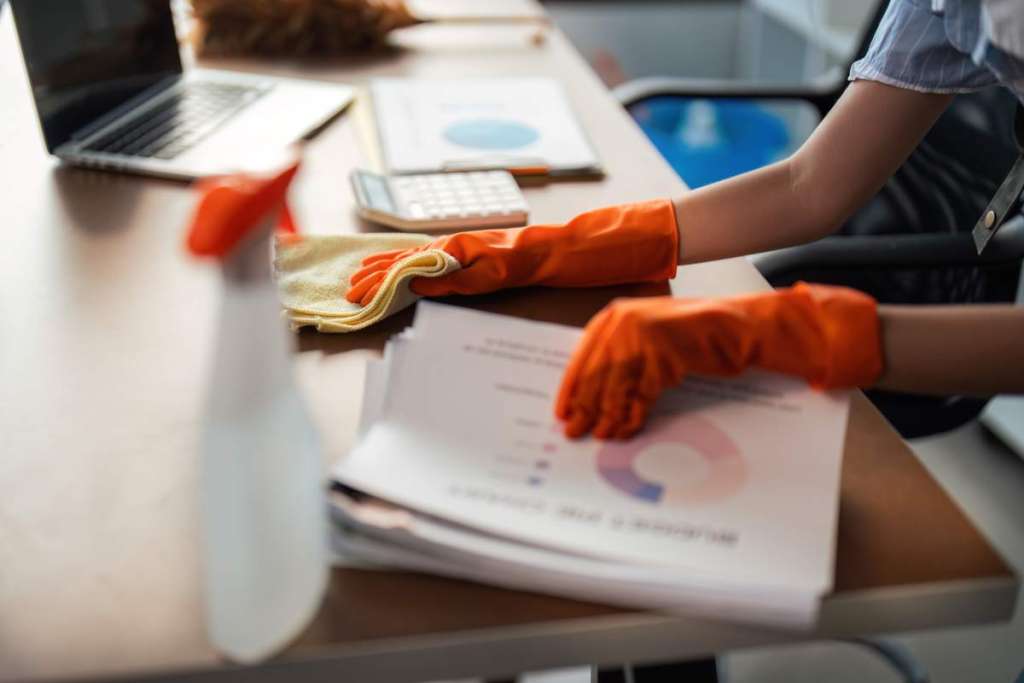
3. Professional Image
The appearance of an office is a reflection of the company itself. A clean and well-maintained office gives a positive impression to clients, visitors, and potential business partners. It shows that the company values professionalism and cares about its environment.
On the other hand, a dirty or untidy office can create a negative perception, making clients and visitors question the company’s attention to detail and overall professionalism. Keeping the office clean helps maintain a good reputation and can even influence business success.
4. Long-Term Cost Savings
Regular cleaning and maintenance of office spaces can help prevent long-term damage to furniture, carpets, and equipment. Dirt, dust, and grime can cause wear and tear on office materials, leading to the need for repairs or replacements sooner than expected. By investing in regular cleaning, companies can extend the life of their office assets and avoid costly repairs or replacements down the line.
This is particularly important for expensive equipment and office furniture that are essential to daily operations.
5. Employee Morale
A clean and well-maintained office can significantly boost employee morale. When employees see that their workplace is taken care of, it instils a sense of pride and belonging. They are more likely to take care of their own spaces and contribute to maintaining a clean environment.
High morale leads to higher job satisfaction, lower turnover rates, and a more cohesive team. In contrast, a dirty or neglected office can lead to low morale, disengagement, and a lack of motivation among staff.
6. Compliance with Regulations
In some industries, maintaining a clean office is not just a matter of preference but a legal requirement. Health and safety regulations often mandate certain standards of cleanliness, especially in sectors like healthcare, food services, and manufacturing.
Failing to comply with these regulations can result in fines, legal issues, and damage to the company’s reputation. Regular cleaning ensures that the office meets all necessary regulations and avoids any potential legal complications.
What Kind of Office Cleaning Do You Need?
The type of office cleaning you need depends on the size of your office, the industry you’re in, and specific needs or preferences. Here’s a breakdown of the different types of office cleaning services that might be necessary:
1. Daily Cleaning
Daily cleaning is essential for maintaining a basic level of cleanliness and hygiene in the office. This typically includes:
- Trash Removal: Emptying trash cans and recycling bins to keep the office tidy and prevent odours.
- Surface Cleaning: Wiping down desks, tables, and other surfaces to remove dust and grime.
- Floor Care: Vacuuming carpets and mopping hard floors to keep them clean and presentable.
- Restroom Cleaning: Ensuring that restrooms are sanitized, stocked with supplies, and free of unpleasant odours.
- Kitchen/Break Room Cleaning: Cleaning countertops, sinks, and appliances like microwaves and refrigerators.
2. Weekly or Bi-Weekly Cleaning
For a deeper clean, you might consider weekly or bi-weekly services, which can include:
- Detailed Dusting: Dusting high surfaces like shelves, light fixtures, and vents that aren’t addressed in daily cleaning.
- Window Cleaning: Cleaning interior windows and glass doors to remove smudges and streaks.
- Disinfecting High-Touch Areas: Focusing on sanitizing doorknobs, light switches, and shared office equipment like printers and copiers to reduce the spread of germs.
- Deep Carpet Cleaning: A more thorough vacuuming or shampooing of carpets to remove dirt, stains, and allergens.
3. Monthly or Periodic Cleaning
Some tasks only need to be done on a monthly or less frequent basis. These might include:
- Deep Cleaning: A comprehensive cleaning that covers all areas, including those that aren’t usually addressed in daily or weekly cleaning, like behind furniture or under heavy equipment.
- Floor Polishing: Buffing and polishing hard floors to restore their shine and protect them from wear and tear.
- Upholstery Cleaning: Cleaning and refreshing office chairs, sofas, and other upholstered furniture to remove stains and odours.
- High-Level Dusting: Reaching and cleaning high surfaces, like ceiling fans, air vents, and light fixtures, that gather dust over time.
4. Specialized Cleaning
Depending on your industry, you might require specialized cleaning services:
- Medical Office Cleaning: If your office is in the healthcare industry, you’ll need specialized cleaning to meet strict hygiene standards. This includes the use of hospital-grade disinfectants and protocols to prevent cross-contamination.
- Industrial Cleaning: For offices in manufacturing or industrial sectors, cleaning might involve dealing with more significant debris, grease, and specific safety requirements.
- Post-Construction Cleaning: If your office has recently been renovated or constructed, a post-construction cleaning service will be necessary to remove dust, debris, and construction materials, ensuring the space is safe and ready for use.
5. Green Cleaning
If environmental sustainability is a priority for your company, you might opt for green cleaning services. This involves:
- Eco-Friendly Products: Using cleaning products that are non-toxic, biodegradable, and environmentally friendly.
- Sustainable Practices: Implementing cleaning practices that reduce waste, conserve water, and minimize energy use.
6. Event Cleaning
If your office hosts events, you may need specialized cleaning before and after these gatherings. Event cleaning typically includes:
- Pre-Event Preparation: Setting up clean and organized spaces before the event, ensuring all areas are presentable.
- Post-Event Cleanup: Cleaning up after the event, which may involve removing trash, rearranging furniture, and deep cleaning areas that were heavily used.
What Are the Most Important Areas to Clean in an Office?
When cleaning an office, certain areas are particularly important to maintain for health, safety, and productivity reasons. These areas can harbour germs, accumulate dirt, or impact the overall impression of the workspace. Here are the most important areas to focus on:
1. Desks and Workstations
- Surface Cleaning: Desks are high-touch areas where employees spend most of their time. Regularly wipe down surfaces, including the desk itself, computer keyboards, mice, and phones.
- Organizing Clutter: Keep workstations tidy by organizing papers, office supplies, and personal items. A clutter-free desk is more efficient and easier to clean.
2. Common Areas
- Reception Area: This is the first area visitors and clients see, so keeping it clean is crucial. Regularly vacuum or mop floors, dust surfaces, and arrange seating neatly. Clean the reception desk and ensure any magazines or promotional materials are tidy.
- Break Rooms and Kitchens: These areas can quickly become messy and are prone to spills and food debris. Clean countertops, tables, and appliances like microwaves, refrigerators, and coffee machines daily. Make sure sinks are cleaned and dishes are not left out.
- Meeting Rooms: Clean tables, chairs, and any equipment like projectors or remote controls. Dust surfaces and vacuum floors to keep the space presentable for meetings with clients or team members.
3. Restrooms
- Sanitization: Restrooms must be cleaned and sanitized daily to maintain hygiene. Clean toilets, sinks, and mirrors thoroughly. Ensure that soap dispensers, toilet paper, and paper towel holders are fully stocked.
- Odour Control: Use air fresheners or cleaning products that help control odours. Regular cleaning of tiles and grout can prevent the buildup of mould and mildew, which can contribute to unpleasant smells.
4. High-Touch Areas
- Doorknobs and Handles: These are among the most frequently touched surfaces in an office and can be hotspots for germ transmission. Disinfect doorknobs, handles, and light switches regularly.
- Elevator Buttons: If your office has an elevator, the buttons should be cleaned frequently, as they are touched by multiple people throughout the day.
- Shared Office Equipment: Printers, copiers, and fax machines are often used by many employees, making them important to clean. Disinfect these devices regularly to prevent the spread of germs.
5. Floors and Carpets
- Vacuuming and Sweeping: Carpets and floors collect dust, dirt, and debris that can affect air quality and create an unkempt appearance. Vacuum carpets and sweep or mop hard floors regularly.
- Spot Cleaning: Address spills and stains as soon as they occur to prevent permanent damage to carpets and floors.
6. Windows and Glass Surfaces
- Window Cleaning: Clean windows allow natural light to enter the office, creating a brighter and more pleasant work environment. Regularly clean both the interior and exterior of windows to remove smudges, dirt, and streaks.
- Glass Doors and Partitions: If your office has glass doors or partitions, keep them clean to maintain a professional look. These surfaces can easily show fingerprints and smudges, so regular cleaning is essential.
7. Trash Bins
- Emptying Trash Bins: Trash bins should be emptied daily to prevent odours and overflowing. Ensure that recycling bins are also emptied and that the office follows proper waste disposal practices.
- Cleaning the Bins: Periodically clean and sanitize the trash bins themselves to remove any lingering odours or bacteria.
8. Air Vents and HVAC Systems
- Dusting and Cleaning Vents: Dust and allergens can accumulate in air vents, affecting air quality. Clean vents regularly to ensure that the office air remains fresh and healthy.
- Changing Filters: Regularly replace filters in HVAC systems to maintain good air circulation and reduce the spread of airborne contaminants.
Final Thought
Cleaning your office might not be at the top of your to-do list every day, but maintaining a clean and hygienic workspace is essential for running a successful business.
It’s important to show your commitment to your employees’ safety, health, and morale, as well as your dedication to making a strong first impression.
A clean and organized office can help you achieve all of this and more.
For the attention to detail your office needs, and to ensure your business always makes a great impression, consider speaking with Enjoy Life Services. As a professional cleaning agency in Sydney, we can handle all your cleaning needs with unmatched precision.
The post Why is Office Cleaning Important? What Kind of Office Cleaning Do You Need? appeared first on In The World News.
What is the half-life concept in radioactive isotope? How can we estimate the half-life of an element? 23 Mar 2023 1:14 AM (2 years ago)
There is big news occurring in Thailand right now as we speak, the Caesium-137 (Cs-137) was stolen and a piece of it has already been melted accidentally. The panic spread all over the country as some scientists say the radiation could affect as wide as a 1,000 km of radius.
Cs-137 is a radioactive isotope of the element caesium. It is produced through the nuclear fission of uranium and plutonium in nuclear reactors and nuclear weapons, as well as during nuclear accidents, such as the Chernobyl disaster in 1986.
The isotope emits beta particles and gamma rays, which can be harmful to living organisms. It has a half-life of about 30 years.
So, now we know that the element has a half-life of 30 years, but why do we estimate it as a ‘half-life’ and not ‘fully decay to non-radioactive’? And how can we calculate it? Did we observe it for 30 years to finally acknowledge it? Let’s find out!
What is the half-life concept in radioactive isotopes?
The reason why scientists use the concept of “half-life” when describing the decay of radioactive isotopes is that radioactive decay is a probabilistic process. It is impossible to predict precisely when a single atom will decay, but it is possible to make accurate predictions about large numbers of atoms.
The half-life of a radioactive isotope is defined as the amount of time it takes for half of the radioactive atoms in a sample to decay into non-radioactive isotopes. This means that after one half-life has elapsed, half of the original radioactive atoms have decayed, while the other half remains radioactive.
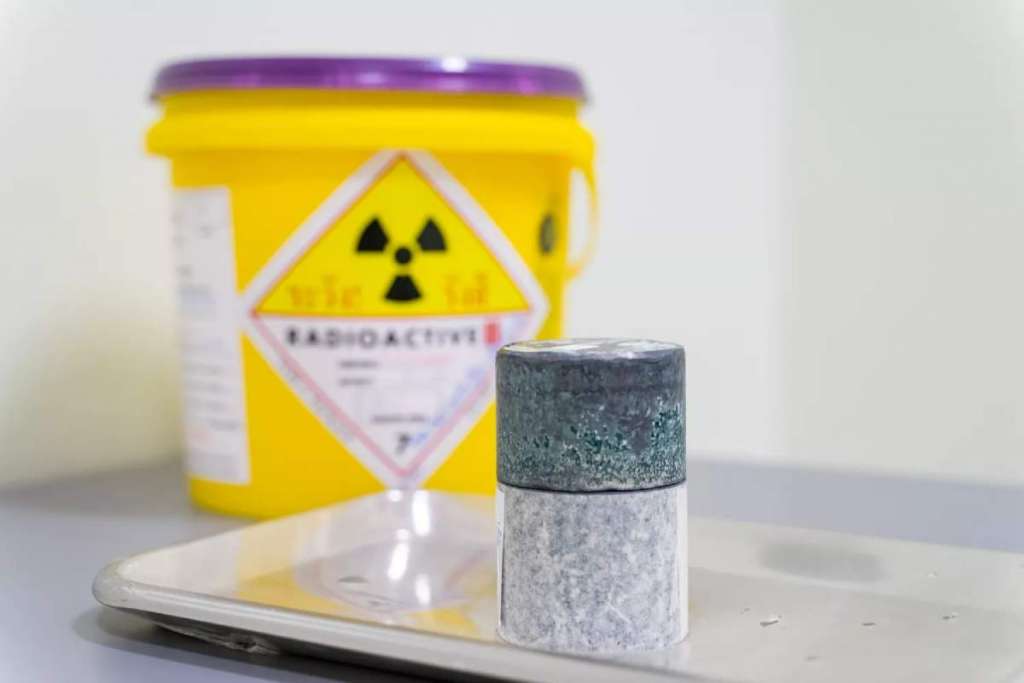
Iodine 131 (I-131), a radioactive isotope used for hyperthyroidism treatment, has a half-life of 8 days
By using the concept of half-life, scientists can predict how much of a radioactive isotope will remain after a certain amount of time has passed. For example, if the half-life of a radioactive isotope is 30 years, then after 30 years, half of the original amount will remain. After 60 years, only one-quarter of the original amount will remain, and so on.
It is not possible for a radioactive isotope to become fully non-radioactive in a finite amount of time because the process of radioactive decay is continuous and ongoing. However, after a sufficiently long time has passed, the amount of the radioactive isotope will become so small that it can be considered effectively non-radioactive for practical purposes.
How can we estimate the half-life of an element? Only by observing?
The half-life of an element can be estimated through various methods, including observation, measurement, and calculation.
One of the most common methods of measuring the half-life of a radioactive isotope is to measure the decay of a sample of the isotope over time. By measuring the amount of radioactive isotope remaining in the sample at different intervals, scientists can calculate the half-life of the isotope.
Another method is to use theoretical models based on the properties of the atomic nucleus, such as the number of protons and neutrons, to predict the half-life of a radioactive isotope. These calculations can be used to estimate the half-life of an isotope before it has even been synthesised.
In some cases, the half-life of a radioactive isotope can also be inferred from other measurements, such as the energy spectrum of the radiation emitted during decay.
It is important to note that the accuracy of these methods can vary depending on the specific isotope and the conditions in which it is measured or calculated. In addition, experimental and observational uncertainties can also affect the accuracy of the estimated half-life. Therefore, it is often necessary to use multiple methods and compare results in order to obtain a more accurate estimate of an isotope’s half-life.

Radiation protector suit
How can radiation affect our bodies?
We all know that we shouldn’t be near anything radioactive because it’s dangerous, but why is radiation dangerous to us, to our bodies?
That is because radiation can cause mutations in organic cells as it damages the DNA molecules within the cells. DNA contains the genetic information that determines the characteristics of an organism, and mutations in DNA can lead to changes in these characteristics.
Radiation can cause DNA damage in a number of ways. For example, it can ionise atoms within the DNA molecule, creating free radicals that can react with and damage the DNA. It can also break the chemical bonds that hold the DNA molecule together, causing the molecule to fragment.
When DNA damage occurs, the cell’s natural repair mechanisms will attempt to fix the damage. However, if the damage is severe or the repair mechanisms are overwhelmed, the DNA may not be repaired correctly, leading to mutations.
Mutations can have a wide range of effects on cells, from minor changes to the DNA sequence to more significant alterations that can affect the cell’s function or even lead to cancer. In some cases, mutations may be beneficial, allowing cells to adapt to changing environments or acquire new functions. However, in most cases, mutations are harmful and can cause genetic disorders, developmental abnormalities, or other health problems.
Therefore, it is important to limit exposure to radiation as much as possible, particularly ionising radiation, which has the greatest potential to cause DNA damage and mutations. This is why radiation safety measures and guidelines are in place to protect individuals from unnecessary exposure to radiation.
What are the benefits of each radiation, why is it widely used in today’s world?
At some point of time, you might be curious yourself that if the radiation or radioactive element is so dangerous, why is it still widely used in today’s world, then? Well, just like electricity or any chemical element, each type of radiation has its own benefits and uses. Such as;

Radioactive Scans by Gamma-ray and X-rays
- Gamma rays and X-rays: These types of radiation are commonly used in medical imaging, such as X-ray machines and CT scans, to diagnose medical conditions and injuries. They are also used in radiation therapy to treat cancer by targeting and killing cancer cells.
- Alpha particles: These particles are used in smoke detectors, as they can ionise air particles and produce an electrical current that can trigger an alarm.
- Beta particles: These particles can be used to treat certain medical conditions, such as eye tumours and skin cancer, by targeting and killing cancer cells.
- Neutron radiation: Neutron radiation is used in a variety of applications, such as materials testing and nuclear power generation.
While radiation has many beneficial uses, it is important to note that exposure to radiation can also have harmful effects on human health. Exposure to ionising radiation can increase the risk of cancer, genetic mutations, and other health problems. Therefore, it is important to limit exposure to radiation as much as possible and to follow radiation safety guidelines and regulations when working with sources of radiation.
In conclusion
The recent theft of Caesium-137 in Thailand is a stark reminder of the dangers of radioactive isotopes and the importance of understanding their properties. The panic that has spread across the country is a clear indication of the fear that comes with exposure to radiation, and it’s crucial that we take steps to protect ourselves and our environment from this potentially deadly substance.
Radioactive isotopes, such as Caesium-137, emit beta particles and gamma rays that can cause severe harm to living organisms, including humans. These particles can cause mutations in organic cells, which can lead to changes in an organism’s characteristics and even cancer.
While the benefits of radiation are clear, we must be cautious and ensure that we handle these isotopes with the utmost care and responsibility. The consequences of mishandling them can be catastrophic, as we have seen in the case of the stolen Caesium-137 in Thailand.
The post What is the half-life concept in radioactive isotope? How can we estimate the half-life of an element? appeared first on In The World News.
5 Ways to Help Sharpen Your Multitasking Skill 14 Mar 2023 1:03 AM (2 years ago)
Are you tired of feeling overwhelmed by the number of tasks you have to complete in a day? Do you want to be able to juggle multiple tasks with ease and get more done in less time? Well, guess what – you can!
With the right mindset and some practical tips, you can sharpen your multitasking skills and become a productivity ninja!
5 ways to help sharpen your multitasking skill
Prioritise your task
Have you ever been faced with a big project that seems impossible to tackle? Maybe it’s a major report at work or a renovation project at home. The thought of starting can be daunting, and it’s easy to get overwhelmed by the sheer size of the task.
But fear not! There is a simple solution to this problem – break it down into smaller, more manageable pieces. This is a fundamental aspect of effective multitasking, and it’s a strategy that can help you get more done in less time.
When you break a big project down into smaller pieces, you’ll be able to focus on each task individually, rather than trying to tackle the whole thing at once. This makes it easier to stay on track and avoid getting sidetracked or overwhelmed by the scope of the project.

For example, let’s say you have to write a 50-page report for work. Instead of trying to tackle it all at once, break it down into smaller tasks. Maybe you start by outlining the key points, then move on to drafting the introduction and conclusion. Once those are done, you can focus on the body of the report, breaking it down into smaller sections or chapters.
Or maybe you’re renovating your kitchen. Instead of trying to do it all in one weekend, break it down into smaller tasks. Maybe you start by clearing out the cabinets and drawers, then move on to painting the walls or replacing the flooring. Once those tasks are done, you can focus on the next steps, such as installing new appliances or adding new lighting fixtures.
Breaking down big tasks into smaller pieces can also help you stay motivated and avoid procrastination. When you see that you’re making progress on the smaller tasks, it can give you a sense of accomplishment and motivate you to keep going. And by avoiding procrastination, you’ll be able to make the most of your time and get more done in less time.
Stay organised
When it comes to multitasking, staying organised is key. And luckily, there are plenty of tools and apps available to help you do just that.
One popular option is a task management app like Trello or Asana. These apps allow you to create and organise tasks, assign due dates and priorities, and track your progress as you complete each task. You can also collaborate with others on shared projects, making it easy to stay on the same page and avoid miscommunications.
Another useful tool for staying organised is a calendar app like Google Calendar. With a calendar app, you can schedule your tasks and appointments, set reminders and notifications, and keep track of your availability throughout the day. This can be especially helpful if you’re juggling multiple projects or appointments and must stay on top of your schedule.
Of course, many other tools and apps are available to help you stay organised, from note-taking apps to project management software. The key is to find the tools that work best for you and your specific needs and then use them consistently to stay on track and make the most of your time.
Your desk or workspace might need to be tidy too, being organised and tidy doesn’t have to mean it is minimalist and dull. You can still add a personal touch to the area you work in without passing up on tidiness. So don’t be afraid to try out different tools and find the ones that work best for you – your future self will thank you!

Learn to switch gear
Learning to switch gears quickly is a crucial skill for successful multitasking. When you’re juggling multiple tasks, it’s important to be able to switch your focus from one task to another seamlessly and efficiently, without losing momentum or getting sidetracked.
One way to practise this skill is by using the Pomodoro technique. This technique involves breaking your work into 25-minute intervals, with a 5-minute break in between each interval. During each 25-minute interval, you focus on one task and then switch to another task during the break. This helps you build the habit of switching gears quickly and maintaining your focus on each task.
Another helpful strategy is to group similar tasks together. For example, if you have to write a report and respond to emails, try to do all of your writing tasks together, and then switch to answering emails. This helps you avoid the mental strain of constantly switching back and forth between unrelated tasks, and allows you to stay focused on one type of task at a time.
It’s also important to eliminate distractions as much as possible when you’re multitasking. Close unnecessary tabs on your computer, put your phone on silent and create a quiet, distraction-free environment for yourself. This will help you maintain your focus and switch gears more efficiently.
Stay in a focused environment
Distractions can be a significant roadblock when it comes to multitasking. However, there are ways to overcome them. By taking proactive steps to reduce distractions, you can create an environment that supports your focus and productivity.
One key strategy is to turn off notifications on your phone or computer. Constant notifications can interrupt your flow and make it difficult to concentrate on the task at hand.

Another way to reduce distractions is to close unnecessary tabs or apps. When you have multiple tabs or apps open, it’s easy to get distracted by something that’s unrelated to your current task.
Finally, creating a quiet, focused environment can also help reduce distractions. Whether it’s finding a quiet spot in your home or office or investing in noise-cancelling headphones, creating a zen space for yourself can help you stay focused and on-task.
Don’t be rushed, take a break
Taking breaks is a crucial aspect of successful multitasking. The human brain can only sustain a high level of focus for so long before it starts to fatigue, so taking short breaks between tasks can help you stay sharp and energised.
There are many ways to take breaks, and the key is to find what works best for you. Some people might prefer to take a quick walk outside to get some fresh air and clear their minds, while others might opt for a cup of coffee or tea to boost their energy levels. Others might find that a short power nap can help them recharge and refocus.
Whatever type of break you choose, the important thing is to make sure that it’s restorative and helps you feel refreshed and ready to tackle the next task. By taking breaks throughout the day, you can improve your mental stamina and multitasking ability, and ultimately get more done in less time.
Final thought
So what are you waiting for? Sharpen those multitasking skills and become a productivity ninja! With a little practice and the right tools, you’ll be juggling tasks like a pro in no time. And who knows? Maybe you’ll even have time for that yoga class or guitar lesson you’ve been meaning to take!
The post 5 Ways to Help Sharpen Your Multitasking Skill appeared first on In The World News.
7 habits that people don’t know they shouldn’t be doing 3 Mar 2023 12:13 AM (2 years ago)
In today’s fast-paced world, our daily habits can have a profound impact on our overall well-being. Some habits may seem harmless, but can actually be detrimental to our mental and physical health.
We are not trying to be a life coach, we just care about you.
In this article, we will explore some common habits that can hold us back, and provide lively tips on how to break them.
Here are 7 habits that people don’t know they shouldn’t be doing:

Checking your phone right before bed
Checking your phone before going to bed has become a common habit for many people. However, this habit can be harmful to your health. The blue light emitted by electronic devices such as smartphones can suppress the production of melatonin, a hormone that helps regulate sleep. This can lead to difficulty falling asleep, poor quality sleep, and disrupted sleep patterns.
Moreover, studies have shown that poor sleep quality can contribute to a range of health problems, including obesity, diabetes, and cardiovascular disease. Therefore, it’s important to avoid using your phone or other electronic devices at least an hour before bedtime to give your brain enough time to wind down and get ready for sleep. Additionally, you can try reading a book, meditating, or doing some relaxation exercises to help you fall asleep faster and sleep better.

Multitasking
Multitasking, or the act of trying to do multiple tasks at the same time, is often seen as a desirable skill in today’s fast-paced world. When you switch between tasks, your brain has to refocus each time, which can result in a loss of momentum and increased errors. Moreover, multitasking can also increase stress levels, leading to burnout and decreased job satisfaction.
Instead of multitasking, it’s better to focus on one task at a time and give it your full attention. This allows you to be more efficient and effective, resulting in better outcomes and reduced stress levels. Additionally, taking breaks and allowing yourself time to recharge can also improve your productivity and overall well-being.

Sitting for too long
Many people spend a large portion of their day sitting at a desk, whether it’s for work or leisure activities. However, prolonged sitting can have negative effects on your health. Sitting for too long can lead to poor posture, and back pain, and even increase your risk for certain health conditions such as heart disease. Studies have shown that prolonged sitting can lead to decreased blood flow and increased inflammation, which can contribute to the development of chronic diseases.
Therefore, it’s important to take regular breaks and move around throughout the day. Simple activities such as stretching, standing up and walking around the office, or taking the stairs instead of the elevator can help reduce the negative effects of prolonged sitting. Additionally, incorporating regular exercise into your routine can also help improve your overall health and well-being. Taking acupuncture or massage once in a while can also help you with posture and some back pain problems.

Skipping breakfast
Breakfast is often referred to as the most important meal of the day, as it provides your body with the necessary nutrients and energy to start the day. Skipping breakfast can lead to low energy levels, decreased concentration, and affect your cognitive function throughout the day. Additionally, skipping breakfast can also lead to overeating later in the day, which can contribute to weight gain and other health issues. Studies have shown that people who skip breakfast are more likely to be overweight or obese than those who eat breakfast regularly.
Hence, it’s important to make breakfast a priority in your daily routine. Simple breakfast options such as oatmeal, yoghurt, or fruit can provide you with the necessary nutrients to start your day off right. Additionally, planning ahead and preparing breakfast the night before can help make it easier to stick to a regular breakfast routine.

Eating while distracted
Eating while distracted is a common habit for many people, whether it’s snacking while watching TV or eating lunch while working on the computer. However, this habit can lead to overeating and poor digestion. When you’re not fully present and aware of what you’re consuming, you’re more likely to eat more than you need or choose unhealthy options.
Additionally, eating while distracted can also lead to poor digestion, as your body isn’t able to fully process and absorb the nutrients from the food. Therefore, it’s important to make a conscious effort to eat mindfully, without distractions. This means taking the time to sit down and fully focus on your meal, savouring each bite, and paying attention to your body’s hunger and fullness signals.

Negative self-talk
Negative self-talk is a common habit for many people, where they engage in negative or critical thoughts about themselves. This can have a detrimental effect on their mental health and self-esteem, leading to feelings of anxiety, depression, and low self-worth. Learning to replace negative self-talk with positive affirmations can help to improve your overall well-being. This means consciously choosing to focus on your strengths and accomplishments, rather than your flaws and mistakes.
It takes time and effort to break the habit of negative self-talk, but with practice, it’s possible to cultivate more positive self-esteem, reduce stress levels, and have a compassionate inner dialogue.

Constantly comparing yourself to others
With the rise of social media and the internet, it’s easy to fall into the trap of constantly comparing yourself to others. However, this habit can have a negative impact on your mental health and overall happiness. Comparing yourself to others can lead to feelings of inadequacy, low self-esteem, and even depression.
It’s important to remember that everyone has their own unique journey and experiences, and comparing yourself to others is often unfair and unrealistic.
Instead, try to focus on your own progress and personal growth. Set realistic goals for yourself and celebrate your own achievements, rather than measuring yourself against others.
Final thought
Breaking these habits may seem daunting, but it is a necessary step towards a healthier and happier life. By making conscious efforts to change these habits, we can improve our sleep, productivity, digestion, self-esteem, and overall happiness.
Don’t be afraid to try new things, take breaks, and celebrate your progress along the way. Remember, small changes can lead to big results. Let’s break these habits and live our best lives!
The post 7 habits that people don’t know they shouldn’t be doing appeared first on In The World News.
Skin Pigmentation: Causes and Treatment 10 Nov 2021 8:48 PM (3 years ago)
Many, if not almost all of us, have some skin pigmentation in the form of freckles, brown spots, sunspots, or age spots. More than 80 per cent of women over the age of 25 suffer from pigmentation and is the second biggest skin concern after wrinkles and fine lines.
Pigmentation can be split into three major types and treated in several ways, which can become quite confusing and disheartening. But first, what causes pigmentation?
Melanocytes, found in the deepest layer of the epidermis, produce melanin. Melanin is a brown pigment that is responsible for the colour of your skin and protects it from the harmful effects of ultraviolet (UV) light. Melanocytes are also found in the hair and in the irises of the eyes.
Hyperpigmentation
Hyperpigmentation is an increase in the melanin content and distribution in the skin. However, when there is too much melanin produced in one area you are left with skin discolouration.
This pigmentation can be triggered by a whole host of factors, which include exposure to UV light, hormonal changes, skin inflammation, injury, and genetics. There are three major types of skin pigmentation:
Solar Lentigines or Sunspots
These are non-cancerous, clearly defined, and pigmented sunspots that are larger than freckles. They are found in the upper layers of the epidermis and are mostly superficial. Lentigines can develop over years or appear suddenly and occur anywhere on the body, ranging from light brown to black in colour.
Being caused by UV light, the degree of the pigmentation depends on the intensity and duration of exposure. Sunspots should be monitored, as they do have the potential to turn into skin cancer and melanoma. Sunscreen and proper sun protection (hats, rash guards, etc.) can help reduce flare-ups and deepening pigmentation. To fade dark marks and patches quickly and safely, prescription pigmentation treatments that contain powerful active ingredients are ideal for smoothing and brightening uneven skin tone and texture.
Post-Inflammatory Hyperpigmentation (PIH)
Post-inflammatory hyperpigmentation occurs as a result of injury to the skin, which includes acne, burns, surgery, scrapes, insect bites, rashes, and aggressive skincare treatments. In some instances, PIH can fade over time – while in other instances it requires a prescription skin pigmentation treatment that considers lifestyle factors and triggers.

Melasma
Melasma is pigmentation that occurs deeper in your skin’s dermis on areas of the face, neck and sometimes the chest and arms. Hyperpigmentation from melasma appears as darker patches in symmetrical patterns (think the centre of the face, forehead, cheeks, upper lip, nose, and chin). It often presents in women more often than in men (just 10% of men suffer from melasma). People with darker skin, those of Latin/Hispanic, African, Asian, Middle Eastern, or Mediterranean descent are much more likely to suffer from melasma.
Melasma is commonly caused by exposure to UV light, which stimulates the skin’s melanocytes. Just a small amount of time spent in the sun can cause melasma to return even after it has faded. This is why there is always an increase in people looking to treat their melasma in the summer.
Changes in hormones can also trigger melasma, most commonly occurring during pregnancy, which is why it is often called “the mask of pregnancy”. Using birth control pills and hormone replacement treatment can also trigger melasma.

Pigmentation Treatments
Lightening and Brightening Creams
Over the counter (OTC) treatments can help decrease pigmentation, and many of these creams are available in clinical-strength prescription formulas. Some of the commonly used ingredients include hydroquinone, liquorice extract, niacinamide and retinoids. While these are more readily accessible, they often take longer than other professional, clinically prescribed treatments.
Clinically Compounded Prescription Creams
If OTC creams and treatments fail to yield optimal results, there is the option of prescription pigmentation treatments that have been tailored specifically to your skin’s needs. After consulting a doctor, who accounts for your lifestyle and skin sensitivity and tolerance, a specialist compounding pharmacist will tailor a customised cream with a blend of active ingredients for fast and safe pigmentation removal.
Dermatologist-approved pigmentation treatment ingredients that are clinically proven to produce results include hydroquinone, retinoids, kojic and azelaic acids, alpha-arbutin, tranexamic acid, and hydrocortisone.
Chemical Peels
Acid and chemical facial peels work by exfoliating the top layer of your skin, encouraging new skin cells to emerge. This process aids in the evening of skin tone and texture. Many of these products are available OTC in drugstores and beauty stores. Look out for a few different ingredients such as alpha-hydroxy acids (glycolic, lactic, citric, and malic acids), azelaic acid, kojic acid, salicylic acid, and l-ascorbic acid.
Although chemical peels are available OTC, consider a professional-grade peel at your dermatologist’s office. These are more powerful, and they yield quicker results.
Laser Peels
Sometimes referred to as ‘resurfacing’, laser peels use targeted beams of light to reduce pigmentation in the skin using ablative or non-ablative lasers. Ablative lasers are the more intensive of the two and are used to remove layers of the skin. Non-ablative lasers target the dermis, promoting collagen production and a tightening of the skin.
Intense Pulse Light Therapy (IPL)
IPL is a form of non-ablative laser treatment that stimulates collagen production in the dermis. Treatment requires multiple sessions to achieve the desired effects, with flat dark patches being particularly responsive to this treatment while it also aids in the reduction of wrinkles, spider veins, and enlarged pores.
Pigmentation Prevention
What is better than treating pigmentation? Prevention! Now that we know that the major contributing factor in the appearance of unwanted pigmentation is sun exposure, sunscreen should be high on your priority list.
A ‘broad-spectrum’ SPF of 30 and above should be your go-to product, and part of your daily skincare routine. Even if the weather is overcast, put on your sunscreen – UVA and UVB light cuts through cloud cover, and UVB penetrates through water. There is no one sunscreen on the market that can give you total protection, which is why sunglasses, hats, and protective clothing are often necessary when the sun is particularly harsh.
While many of us do suffer from unwanted pigmentation, there are a whole host of ways to treat, manage and prevent future flare-ups. Finding the right combination for your skin can take time while seeking the help of a dermatologist can greatly increase your chances of success.
The post Skin Pigmentation: Causes and Treatment appeared first on In The World News.
What does commercial painting mean? What do commercial painters do? 30 Jun 2021 6:56 PM (3 years ago)
If you’ve always wondered what commercial painters do but have always been afraid to ask, don’t worry. You don’t know until you know, right? And when there are so many different types of painters (residential, commercial, and industrial to name a few), it can be difficult to understand the ins and outs of each job type. So, what does commercial painting mean? And what is it that commercial painters actually do? In this article, we are going to lay it out for you so that you can fully understand it, and decide if commercial painting is something that you can benefit from.

What does commercial painting mean?
In a nutshell, commercial painting refers to the process of painting for commercial properties and businesses. So, for example: if you own a retail store and would like it re-fitting, renovating, or simply need a fresh lick of paint, then a commercial painter will be ideal for you.
The same applies with office buildings, shopping centres, and any other form of customer-facing business.
A residential painter focuses on painting houses and homes. Whereas industrial painting refers to factories and warehouses and other industrial type properties. But what are the key differences between them all? What separates a commercial painter from a residential or industrial painter, for example?
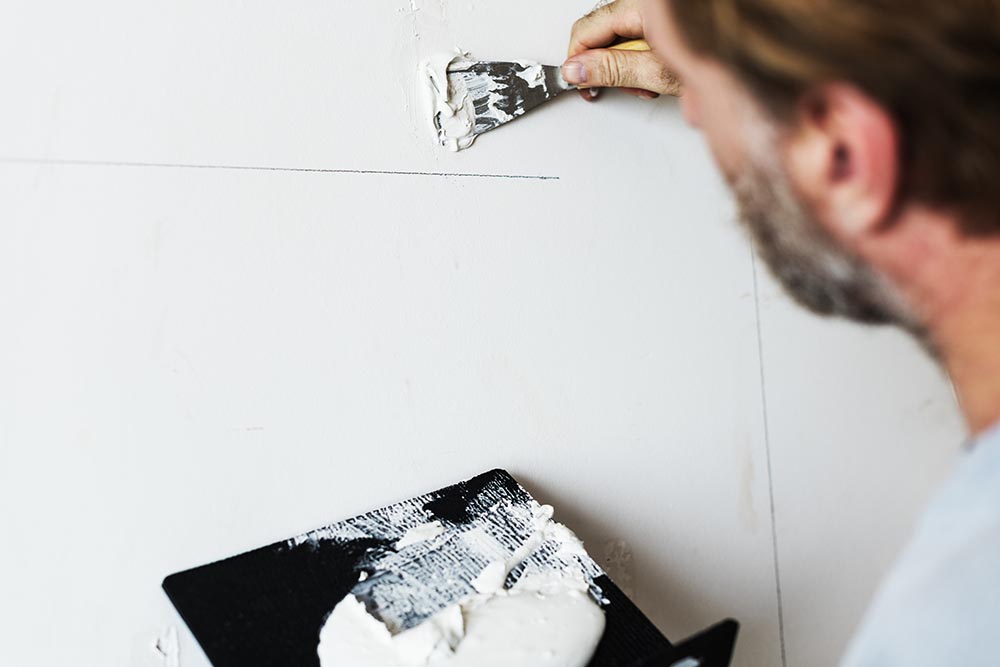
The difference between Commercial, residential, and industrial painting
Surely there can’t be that much of a difference between the three, can there? Painting is just painting right? Well, you’d be surprised by how much differentiation there is between the three.
Let’s start with “commercial painters” :
- Colour psychology (how colour can influence potential customers and even influence buying decisions).
- The type of paint (certain paint types are unsuitable for a customer-facing establishment)
- Time to dry (most businesses want their establishments re-painting in as quick a time as possible so as to not negatively impact their earnings.
- Speed (most commercial painters need to be able to complete the job to an exceptional standard, as quickly as possible).
- Ensuring a building is up to code
- Quality preparation

Residential painters:
- Furniture and blinds need to be covered or removed
- They deal face-to-face with their customers in their own homes
- Covering and masking before painting
- Cleaning the various surfaces
- Scraping and sanding
- Clean-up
Industrial painters:
- Durability (in certain factory settings where toxic substances may be in use, there needs to be a suitable paint finish that can live up to it)
- Longevity (you don’t want to have to re-paint a factory or warehouse every other month)
- The danger-factor (industrial painters may often be required to use scaffolding, ladders, and other equipment or machinery in order to help them work safely at greater heights).
- Surface preparation and cleaning
- Colour psychology (how will the colour effects the workers and influence morale?)
- Considering potential tour routes (a factory may regularly receive visitors and must be suitably well-presented).
- Working around dangerous equipment
You will find that many of these points are synonymous throughout the three jobs types. They each have to abide the clients wishes. They all have to work quickly and to an exceptional standard. And of course, they all must be thorough in their application, including any preparation work. However, on the whole, there are a number of differences that make each job type unique.

What do commercial painters do?
Commercial painters transform commercial buildings. Every shop you walk into, every entertainment venue you explore, all of your favourite pubs and restaurants, have each been tended to by commercial painters. These professionals are well-versed in creating stunning features in customer-facing establishments and there is much thought and preparation that must go into it.
Painting somebodies home is no easy job, but painting a commercial property is a different story entirely, with all manner of pressures and expectations that go along with it.
Conclusion
If you have a business and an establishment that needs a bit of love and a fresh lick of paint, then Platinum 3 Painting would be our recommendation. A long-established business with a solid reputation for delivering quality commercial painting solutions. You really can’t go wrong and your business will certainly benefit from the professional touch.
The post What does commercial painting mean? What do commercial painters do? appeared first on In The World News.

